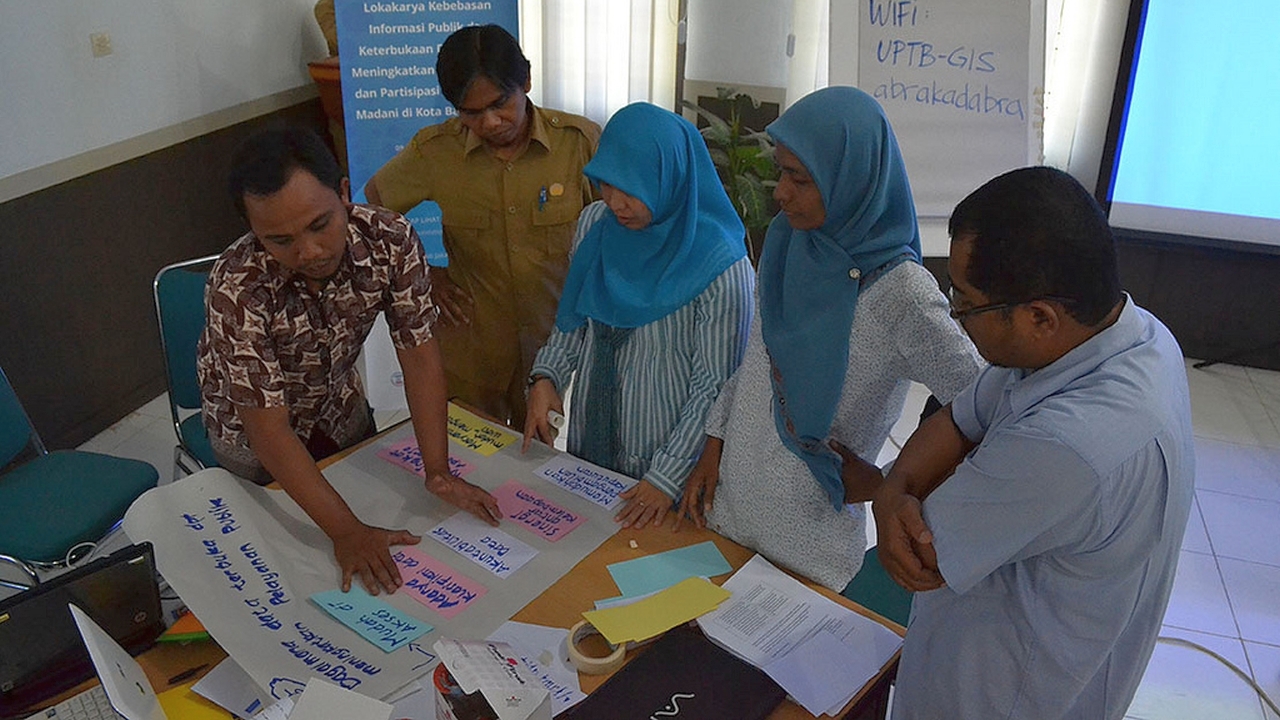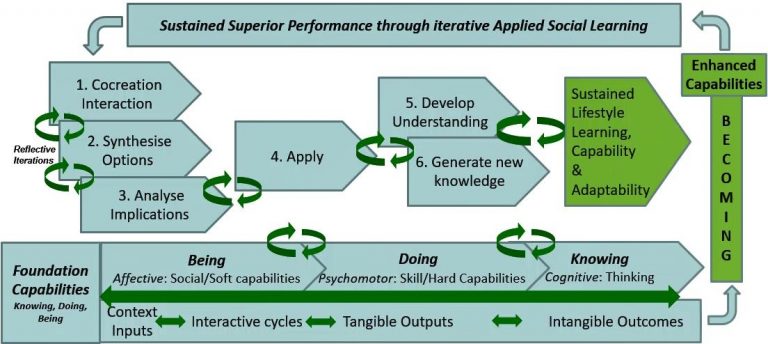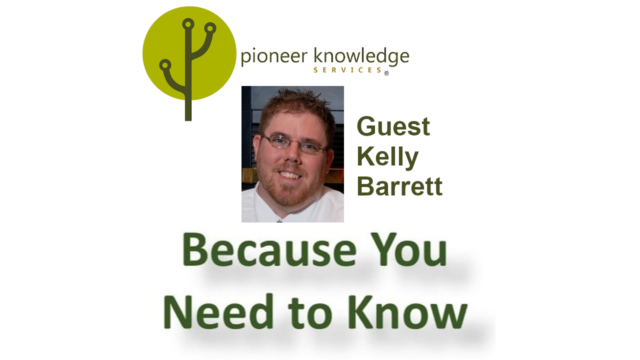
Iterative and collaborative social learning through the Reverse Bloom Learning Framework (RBLF)
Bloom’s taxonomy1 is a set of three hierarchical models used to classify educational learning objectives into levels of complexity and specificity. The three models list learning objectives in the cognitive, affective, and psychomotor domains. They were named after Benjamin Bloom, who chaired the committee of educators that devised the taxonomy.
Although there are three models, the 1956 cognitive domain list2 has been the primary focus of most traditional education and is frequently used to structure curriculum learning objectives, assessments, and activities.
The original elements of Bloom’s cognitive domain taxonomy indicated that learning was built through six levels of learning in increasing richness – knowledge, comprehension, application, analysis, synthesis, and evaluation.
A widely accepted revised version of the cognitive domain taxonomy was published in 2001, based on verbs and switching the order of the last two elements. This version describes the outcomes the learner was able to achieve at each of the levels, highlighting the actionable aspect of learning and the importance of it being learner centered. In ascending order, the revised levels were remember, understand, apply, analyse, evaluate, and create.
In the more recent 2017 revision shown in Figure 1, Dr Arthur Shelley3 changed create to co-create. This highlights that collaborative learning enables the incorporation of a range of perspectives, which is superior to the individual development of concepts and capabilities.

Reverse Bloom: A new hybrid approach to experiential learning
In a newly published paper5, Dr Shelley reveals a significant further development of Bloom’s taxonomy.
He suggests that although the latest six elements of the cognitive domain of Bloom’s taxonomy remain valid, more effective learning can be achieved by reversing their order and reintroducing the affective and psychomotor domains into collaborative learning experiences.
Figure 2 introduces the new approach, called the “Reverse Bloom Learning Framework” (RBLF). Rather than using the six elements as a linear hierarchy to transfer existing knowledge to build capabilities, as is common in the education profession, the RBLF incorporates all three Bloom domains and proposes a reversal of the “order” of the cognitive domain. That is, from co-creation “down” to knowledge, rather than the traditional approach from knowledge up to creation.

In the RBLF approach, much of the knowledge generated is new, rather than just a transfer of prior existing knowledge, as each person can perceive the concept in a different way. This highlights why reflective conversations about their perspectives and understanding are important throughout the whole process. It enables all learners to benefit, from the understanding of everyone involved, not just from their own insights. They could possibly learn from reflections of prior learners as well, if artefacts for those experiences have also been kept. These reflective conversations happen throughout all cycles in the process to generate not just an understanding of the original concept, but a greater set of insights and new possibilities for adaption of the concepts into other options or fields.
A very significant and timely development
The development of the Reverse Bloom Learning Framework (RBLF) is very significant and timely because it aligns with and strengthens emerging research findings and professional practice experience in regard to iterative and collaborative learning.
For example, here in RealKM Magazine, we have documented:
- advice from the Overseas Development Institute (ODI) in regard to iterative impact-oriented monitoring7
- a cyclical model for rapid learning and action in the face of COVID-19 uncertainty that was developed and implemented in the NHS Nightingale Hospital London8
- a five-step process for collaborative leadership in the face of wicked problems9
- a case study of iterative and collaborative cyclical learning in a major program.
Because of this growing evidence base, we have recommended that such approaches be much more widely used.
Implementing the RBLF approach
Design of learning activities and assessments for the RBLF approach
The Reverse Bloom Learning Framework (RBLF) is designed to be flexible, so that the principles of this learning approach can be applied to any level of learner (young children through to executives). The generic steps to design a learning intervention and assessment are:
- Assess the foundational capabilities (knowledge, skills and social/behavioral) of the learners to determine current and desired states and define the gap.
- Consider the context of the learning and a real challenge to be resolved within this by the learners.
- Define learning objectives across all three domains (cognitive, psychomotor, and affective) based on the learning outcomes to fill the capabilities gap.
- Create a series of learning activities that are inclusive social experiences in which learners explore possibilities relevant to the challenge context.
- Construct an assessment rubric that clarifies the changes to be demonstrated through the learning. Note this is likely to include some subjective measures of the quality of the capabilities. This is inevitable in social systems and happens all the time in workplaces. The rubric should be as explicit as possible to guide the learners, but not so rigid to disallow unpredicted creative solutions that the facilitator has not considered, remembering that the RBLF acknowledges the value of co-creating new possibilities in addition to existing knowledge, within the context.
- Facilitate learning interventions that provoke divergent thinking and social exchanges around possibilities and prioritise actions.
- Assess outputs and outcomes against the defined learning criteria.
- Provide meaningful and balanced individualised feedback. Feedback is optimal when it highlights the aspects that have been done well (demonstrated capabilities against planned learning outcomes defined in the rubric) and the aspects that could have been done better (learning gaps not met as defined by the rubric). If the planned learning is ongoing, as is usually the case in formal learning, the learner proceeds to the next learning activity. That is, back to step 1 for the new set of learning outcomes and activities.
- Facilitate a reflective conversation with the learner is sometimes appropriate where the feedback is not understood or needs to be clarified.
Extend the learning into professional practice. Assessing the impacts generated when capabilities are put into professional practice is helpful to refine capabilities. This encourages ongoing use of the learned capabilities to continue their development.
A starter on RBLF principles
Principles of learning for the Reverse Bloom Learning Framework (RBLF) are not significantly different from those in the general learning literature. However, more emphasis is applied to social interactions and iterative action learning. No doubt, as others experiment with the RBLF, more principles will emerge. The list below is not meant to be comprehensive, but offers a useful set of principles to begin designing and implementing your RBLF interactions:
- Engage to open minds rather than fill them, emphasise context over content.
- Aim to co-create a range of options rather than finding an existing answer.
- Embed iterative collaborative cycles of divergent and convergent thinking, laced with social challenges to explore the emotional and human aspects of the topics.
- Reinforce that creativity is a critical part of learning, as are sense making and play.
- Stimulate Creative Friction (constructive challenges to deliberately clash alternatives to co-create new possibilities) as a key driver.
- Proactively facilitate learner-centered experiences, with balanced cognitive, affective, and psychomotor aspects.
- Optimal learning builds the capabilities and confidence of the learner to safely enter the unknown and explore (expanding their comfort zone).
- Social connections and trusted relationships should be outcomes of the learning.
- Invest heavily in reflective conversations through collaborative cycles to share perspectives.
- Invest in designs and facilitation that are inclusive of all perspectives.
- Aim to develop well-rounded people who feel competent to generate value from applying collaborative learning to continue to refine their capabilities ongoing.
Please share your insights and learnings from use of the RBLF, to help amplify what we can collectively achieve to further mature the approach.
Header image: Open government co-creation workshop, Manila. Open Data Labs, CC BY 4.0.
References and notes:
- Wikipedia, CC BY-SA 3.0. ↩
- Bloom, B. S., Engelhart, M. D., Furst, E. J., Hill, W. H., & Krathwohl, D. R. (1956). Taxonomy of educational objectives: The classification of educational goals. Handbook I: Cognitive domain. New York: David McKay Company. ↩
- Dr Arthur Shelley is a RealKM Platinum Patron and also a RealKM director. ↩
- Shelley, A. W. (2017). KNOWledge SUCCESSion. Sustained performance and capability growth through strategic knowledge projects. New York, NY: Business Expert Press. ↩
- Shelley, A. W. (2020). Reverse Bloom: A new hybrid approach to experiential learning for a new world. Journal of Education, Innovation and Communication (JEICOM) 2(2), 30-45. ↩
- Shelley, A. W. (2020). Reverse Bloom: A new hybrid approach to experiential learning for a new world. Journal of Education, Innovation and Communication (JEICOM) 2(2), 30-45. ↩
- Jones, H. (2011). Taking responsibility for complexity: How implementation can achieve results in the face of complex problems. Overseas Development Institute (ODI) Working Paper 330. London: ODI. ↩
- Bohmer, R., Shand, J., Allwood, D., Wragg, A., & Mountford, J. (2020). Learning systems: managing uncertainty in the new normal of Covid-19. NEJM Catalyst, 1(4). ↩
- Karelaia, N., & Van der Heyden, L. (2020). Leading in Wicked Times: A Radical Shift to Inquiry, Humility, and Fairness. INSEAD Working Paper 2020/34/DSC/TOM. ↩
Also published on Medium.







Thanks for sharing this terrific sort summary of the RBLF Bruce. I hope that many people see the value in this approach ifor their initiatives and apply it to stimulate collaboration, build relationships and cocreate social value.
Great review and insight. I truly believe that the RBLF could help shift how learning interventions are designed and conducted, and potentially deliver relevant context-based insights that will stick to the learner. The iteration and collaborative process also facilitated testing and retesting of learners (and facilitator’s) understanding and knowledge! Thanks Bruce and Arthur for the write ups.